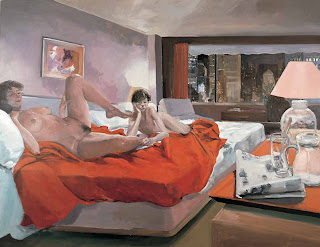 |
| Chris Ofili's The Holy Virgin Mary |
By looking at works of art that have been put under the category of controversial and examining critic and public responses, Barrett identifies the connection between interpretation and judgement. He pinpoints four categories of controversial artwork and gives key examples of artists and their works that have received negative feedback.
Religiously Controversial Art- In October of 1999, an exhibition at the Brooklyn Museum of Art in New York contained a painting by Chris Ofili called, The Holy Virgin Mary. Ofili's Virgin Mary is black with African facial features and is surrounded by cut outs of butts that resemble angel wings. Protestors from the Catholic League stood outside the museum to hand out 'vomit bags'. The controversy went national when the mayor of New York condemned it and demanded the painting to be removed. Ironically the mayor had not seen the painting but claimed it represented "Catholic Bashing" and "Hate Speech".
 |
| Eric Fischl's Birthday Boy |
 |
| Norman Rockwell's Four Freedoms |
Ideologically Controversial Art- Not all controversial art pertains to social or cultural taboos. Sometimes the controversy is simply critic disagreement on whether or not an artist's work deserves artistic acknowledgment and serious interpretation. The American illustrator Norman Rockwell (1894-1978) created more than 4 thousand images in his life, mostly for magazine covers, and advertisements for campaigns and companies. His Four Freedoms was viewed by over 25 million people during World War II. Much of his work consisted of American suburban family life, accentuating aspects of social stereotypes that were associated with the idea of 'the American Dream'. Many critics found his works to be bland and too transparent to have received interpreted thought. Whereas with the recent trend in vintage and 'retro' artwork, Rockwell's art has been getting more attention. Laurie Moffatt of 'Newsweek' wrote, "Norman Rockwell reminds us of our humor and humility, our happiness and humanity. Those are not bad qualities to embrace."
 |
| Michael Ray Charles' Cut and Paste |
Racially Controversial Art- There are artists that cause controversy by using explicitly racial and racist subject matter in their artwork to express and raise awareness of social issues that should be addressed. The African American painter, Michael Ray Charles, focuses on stereotypical racist images of blacks within American visual culture which are associated with slavery, southern black folklore, and 19th century minstrel shows. His satirical painting Cut and Paste, asks his viewers to attach stereotypes of choice to a man running down the street. Football, hair pick, banana, knife, chicken, purse, handgun, or tie? Filmmaker Spike Lee wrote in a catalogue of Charle's work, "Michael Ray Charles attacks some serious issues and with a deft humor, which is very hard to do. He makes you laugh whiles he's killing you. That's a real artist. "Black viewers are frequently the viewers that are most offended by Charles, depending on age and geographic regions, according to Juliette Bowles, a writer for International Review of African American Art. Some critics argue that his artwork, and others like him are "making their reputations and large sums of money off of their own people's suffering, and are repeating monotonous themes to exhaustion, and are catering to the base interest of white curators and collectors."
By reading through the short summaries of Barrett's four controversies and his examples, there aspects from each type that form the base of artistic controversy. All controversy, artistic or not, has more than one side of interpretation. Aesthetic judgments of art are typically based an individual's or a group of peoples' moral criteria. These moral criteria's contain their norms, values, and beliefs which also contains their emotional and social taboos. What crosses the line of 'comfort' for one person can simply be another person's everyday perception on an aspect of life. For an art critic, when interpreting and responding to a piece of art that encompasses subject matter that could be viewed as rude or offensive, it is important to take in all surrounding point of views on the piece in order to give a well rounded response. Barrett states, "Multiple interpretations of a controversial work of art can bring rationality to a controversy."























